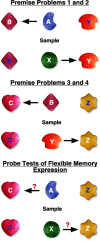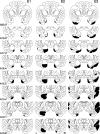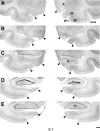Entorhinal cortex lesions disrupt the relational organization of memory in monkeys
- PMID: 15525766
- PMCID: PMC6730224
- DOI: 10.1523/JNEUROSCI.1532-04.2004
Entorhinal cortex lesions disrupt the relational organization of memory in monkeys
Abstract
Recent accounts suggest that the hippocampal system critically supports two central characteristics of episodic memory: the ability to establish and maintain representations for the salient relationships between experienced events (relational representation) and the capacity to flexibly manipulate memory (flexible memory expression). To test this proposal in monkeys, intact controls and subjects with bilateral aspiration lesions of the entorhinal cortex were trained postoperatively on two standard memory tasks, delayed nonmatchingto-sample (DNMS) and two-choice object discrimination (OD) learning, and three procedures intended to emphasize relational representation and flexible memory expression: a paired associate (PA) task, a transitive inference (TI) test of learning and memory for hierarchical stimulus relationships, and a spatial delayed recognition span (SDRS) procedure. The latter assessments each included critical "probe" tests that asked monkeys to evaluate the relationships among previously learned stimuli presented in novel combinations. Subjects with entorhinal cortex lesions scored as accurately as controls on all phases of DNMS and OD, procedures that can be solved on the basis of memory for individual stimuli. In contrast, experimental monkeys displayed deficits relative to controls on all phases of the PA, TI, and SDRS tasks that emphasized the flexible manipulation of memory for the relationships between familiar items. Together, the findings support the conclusion that the primate hippocampal system critically enables the relational organization of declarative memory.
Figures












References
-
- Amaral DG, Witter MP (1995) Hippocampal formation. In: The rat nervous system, Ed 2, pp 443-493. New York: Academic.
-
- Amaral DG, Insausti R, Cowan WM (1987) The entorhinal cortex of the monkey: I. Cytoarchitectonic organization. J Comp Neurol 264: 326-355. - PubMed
-
- Bechara A, Tranel D, Damasio H, Adolphs R, Rockland C, Damasio AR (1995) Double dissociation of conditioning and declarative knowledge relative to the amygdala and hippocampus in humans. Science 269: 1115-1118. - PubMed
Publication types
MeSH terms
Grants and funding
LinkOut - more resources
Full Text Sources
Other Literature Sources
Medical
